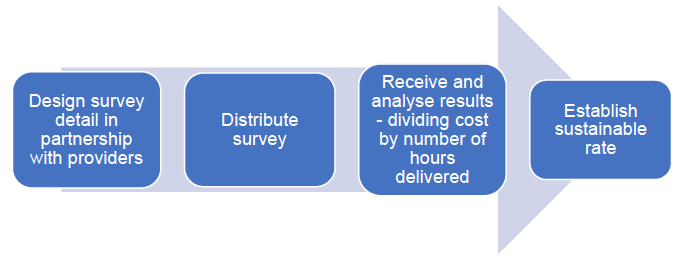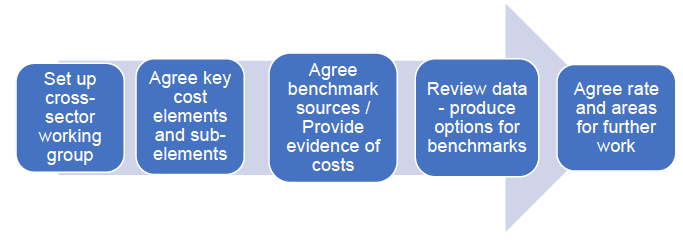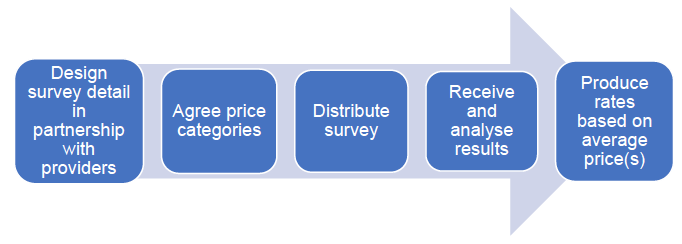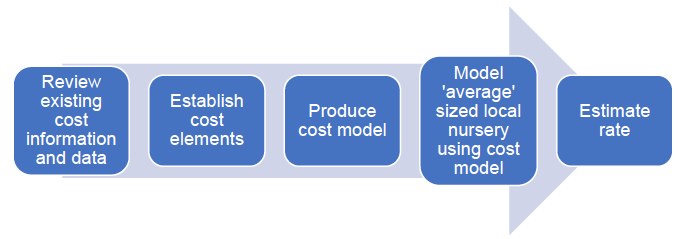Funding follows the child and the national standard for early learning and childcare providers: guidance for setting sustainable rates from August 2020
This document provides guidance to enable local authorities to set a sustainable rate that is paid to funded providers in the private and third sectors.
Section 5: Options for Local Rate Setting
57. There are a number of processes that can be used to gather information to establish a sustainable rate. The processes outlined in this section will support local authorities to establish an average rate for the cost of ELC in their area.
- 5.1: Survey (Costs) – Review detailed cost information provided by private and third sector providers;
- 5.2: Working Group - Agree, for each cost, a percentage (%) figure and indicative cost through a working group;
- 5.3: Survey (Prices) - Review current rates charged by private and third sector providers in the local area; and,
- 5.4: Cost Modelling – Develop costs based on modelling of an 'average' local ELC setting.
58. It should be noted that a local authority may choose to use a process, aligned with their available resources, that uses the principles and the points explained in Section 4 (Developing a Local Rate) of this document but which differs from the processes outlined in this section.
5.1: Survey (Costs)
59. In this option, the local authority would survey funded providers to establish an average cost based on actual evidenced expenditure. This would yield an average hourly rate that can then be used as the benchmark for a sustainable rate. Figure 1 shows the steps involved.
Figure 1: Overview of process – Survey (Costs)

60. As part of this process, funded providers need to evidence actual incurred costs, for example, through balance sheets, profit and loss accounts and any other evidence of actual expenditure to show the different costs incurred. It is likely that the local authority would require significant support from finance colleagues or an external source, to review this information in a timely way. Finance officers should be involved in this process.
61. A local authority would use this information to understand the cost structure of their local private and third sector providers, including childminders, and identify a sustainable rate which reflects the average cost of delivering the service in their area.
62. This can be a resource-intensive and time-consuming process dependent on the number of providers. However, it is based on actual costs (as long as evidence is provided) and, therefore, can be used to understand the impact on the average rate of changes in factors such as the real Living Wage or inflation.
Worked Example
63. The local authority would meet with funded providers to design the survey that will be used to collect cost information. The survey should consider the main cost elements and any sub-headings within these (see Annex A) and the number of hours delivered. It is essential to include provision for profit / surplus or earnings in terms of ensuring continued investment and continuing services in the sector (as per Annex A). The local authority would then devise a form based on this to be completed by each provider, for example, in the form of a spreadsheet.
64. This will allow the local authority to consider the same information, in the same format, from every provider. The local authority may request evidence for incurred costs. Evidence may include information found in balance sheets, profit and loss accounts, management accounts or similar. A local authority may choose to verify information provided to ensure its accuracy. This could be done using a benchmark or external source.
65. Note: If the local authority is considering setting a tiered rate, the form may change depending on the information required, for example, childminders may fill in a form that reflects the nature of their setting compared to private nursery settings.
66. Funded providers would be given a fixed time period to submit their return and the local authority would keep a record of those private and third sector providers that submit evidence or any other correspondence received regarding the process.
67. Local authority staff (including finance officers) would then review the survey returns and evidence, requesting clarification, if required. The local authority should confirm that no commercial information submitted is shared with other funded providers.
68. Where the local authority wants to review costs based on the different types of provider, they would separate providers into categories, for example, private providers, third sector providers and childminders. The local authority could then establish different average costs per type of provider.
69. The total average cost incurred divided by the total number of hours delivered by private and third sector providers would then produce the average hourly cost. This can be used as the benchmark for a sustainable rate. If the local authority is considering setting a tiered rate for different settings, this should be repeated by provider type.
70. This process could be undertaken on a regular basis (i.e. annually) in order to ensure the rate reflects the cost of providing the service. An alternative option would be to review changes to key cost drivers, such as changes in the real Living Wage and inflation, to ensure the rate remains sustainable.
5.2: Working Group
71. The local authority would set up a working group (or use an existing group) to establish a range of benchmarks for costs. Funded providers and local authorities would work together to agree, for example, working group participation, the cost structure and make-up of the local market, agreeing on the formula used for local costs. Figure 2 shows the steps involved.
Figure 2: Overview of process – Working Group

Worked Example
72. The local authority may initially set up an internal meeting with procurement, legal and finance representatives to agree structure, scope and time limits for the process. The local authority would consider the data protection implications of such exercises (for example, childminder data) with their own internal specialist advisers and take necessary steps to comply with data protection requirements.
73. The local authority would then set up a meeting with funded providers to agree the costs that inform the rate. The meeting should include representatives from finance, procurement and potentially a neutral or third party and providers which were representative of the mix of private and third sector providers, including childminders, in a local area. This approach works well when there is an existing representative group of providers and good communication with providers across the local area.
74. The working group would then agree the costs associated with each type of provision. A detailed overview is shown in Annex A, however, a basic summary showing the considerations between childminders and private and third sector settings is shown in Table 5. It is essential to include provision for profit, surplus or earnings in terms of ensuring continued investment and continuing services in the sector (see Annex A).
75. After key cost elements and sub-headings are agreed, benchmark sources would also be agreed. For example, wages could be based on average salaries advertised in the area with additional cost estimates (on-costs) to cover National Insursance, pension and holiday / sickness cover. Annex B illustrates a number of key questions which need to be answered in respect of each benchmark for staffing, before moving to agree the cost value.
Table 5: Summary of cost considerations
| Childminder | Private / Third Sector |
|---|---|
| Earnings | Staff |
| Utilities | Mortgage / rent |
| Consumables | Utilities |
| Play and learning equipment | Consumables |
| Building maintenance and repairs | Play and learning equipment |
| Transport | Building maintenance and repairs |
| Catering costs | Transport |
| Overheads (accountancy fees, bank charges, ICT systems, insurance costs etc.) | Catering costs |
| Staff training | Overheads (accountancy fees, bank charges, ICT systems, insurance costs etc.) |
| Staff training | |
| Profit / surplus |
76. The working group would develop the benchmarks for each of the cost elements and agree on the source of data for each one. When the benchmarks are agreed, values can be calculated for each cost element and totalled to create an hourly rate.
77. Where public benchmark sources are not available, the local authority may request evidence from private and third sector providers to verify actual costs incurred.
78. By agreeing benchmarks, this process can be used over a predetermined number of years and does not need to be conducted on a regular basis. For example, if wage costs are set at the real Living Wage, then any change in this is reflected annually in the rate. Therefore, the rate reflects any relevant changes in staffing costs and inflation. Generally, the benchmarks and values would be reviewed between 3 to 5 years to ensure that they are still relevant to the cost of delivering these services.
5.3: Survey (Prices)
79. The local authority would survey local funded providers to establish their current price for a standard day (for example, 8 am to 6 pm) or, for example, an average rate charged over the different sessions run throughout the day. Some settings may charge a different hourly rate depending on the length of the session being purchased, with a full-day session often having a lower average hourly charge relative to a half-day session and this would be taken into account when setting a sustainable rate. Figure 3 shows the steps involved.
Figure 3: Overview of process – Survey (Prices)

80. To evidence this, the local authority may request a sample of pricing schedules or invoices. By focusing only on the price charged rather than costs, this process does not yield information on the impact of the real Living Wage on staff costs, or the impact of inflationary increases. However, it is assumed that providers set their prices with reference to their underlying costs of delivery plus an adjustment for profit / surplus.
81. By gathering price information from funded providers, this can be used to confirm an average rate based on local market conditions, on the assumption that the averages prices being charged by private and third sector providers reflect the costs of delivery plus a mark-up for return on investment / profit. This can then be used as the benchmark to inform a sustainable rate.
Worked Example
82. The local authority would design a survey to collect pricing information from private and third sector providers. The survey may be designed in partnership with these providers and could include different price categories.
83. The local authority would then request evidence of the pricing fee structure and prices charged.
84. Funded providers, as per National Standard Criteria 9: Payment Processes, must clearly and transparently set out the fee structure for any hours purchased in addition to the funded hours, therefore evidence requested from private and third sector providers, in addition to the survey return, may include charging statements or invoices to parents, branded marketing leaflets or similar.
85. Funded providers would be given a designated time period to submit these to the local authority.
86. Local authority staff, including procurement, would then review the evidence submitted and maintain commercial confidentiality. No commercial information sent to the local authority can be shared with other funded providers. A rate could then be generated based on an average hourly rate across private and third sector providers that responded.
87. It should be noted that this process does not account for the difference between the price charged and the cost to provide the service. It also does not clarify the impact that any changes to the real Living Wage and inflation would have on the rate.
88. This process could be conducted on a regular basis to review if the rate offered is in line with the rates charged by the market.
5.4: Cost Modelling
89. In the event that no cost data is available, or provided, by private and third sector providers then a local authority could undertake research to establish a 'model' cost based on the average size and scale of provision in their local area. This would reduce the need for funded providers to share information, however, it would potentially give less accurate results. Figure 4 shows the steps involved.
Figure 4: Overview of process – Cost Modelling

90. In this case, it is imperative that where mechanisms or formulas are used, these are clearly set out and explained. Additionally, the local authority should record and be transparent with regards to what has been taken into consideration during the process and what has been omitted, including the reasons for this. The cost considerations could be broadly based on those outlined in Annex A.
Worked Example
91. The local authority would base the modelling on information available, for example, through its finance or education department or public data sources. The local authority would agree the main cost elements and any sub-headings internally and supplement cost information from its own settings with estimates for costs it would not incur.
92. The local authority would complete a template (for example based on the table presented in Annex A) to show the main cost elements and any sub-headings with populated figures and the estimated average hourly rate that this would yield.
93. Where estimates are used in the figures, these should be highlighted within the published information.
94. The local authority can consider the real Living Wage commitment within the cost structure and use the populated template to consider / apply any real Living Wage and inflationary changes to the figures.
95. Although this process is not based on actual cost data supplied by private and third sector providers, it provides a transparent and consistent process to setting a sustainable rate, and the local authority could provide detailed information on the data sources for the cost data.
96. This process would need to be updated on a regular basis to ensure that the rate consistently reflects the costs incurred.
5.5: Process Summary
97. The table below outlines the processes discussed in this section and highlights further considerations that may assist a local authority when it is deciding which particular process to use when establishing a sustainable rate.
98. For example, if time and cost are important considerations then a Cost Modelling or Survey (Prices) process may be the best method to determine a sustainable rate. However, this may need to be conducted annually to reflect changes in relevant cost drivers and inflation.
99. If the key driver is transparency and building on existing relationships with providers, then the working group approach may provide a longer-term solution and prevent the need for undertaking an annual process.
100. If the local authority wants to understand the impact of changes in cost factors on the rate, then the Survey (Costs) method would provide this transparency.
101. Regardless of the process chosen, it is important that the process is transparent, based on evidence and shared with private and third sector providers (including childminders) locally.
Table 6: Summary of processes to set sustainable rates from 2020
| Process | Key Requirements | Key Considerations | Further Considerations |
|---|---|---|---|
| Survey (Costs) | A form for providers to submit cost information. Guidance for completing forms / information requests. Willingness of local authorities and providers to engage: High |
|
|
| Working Group | Clear roles and responsibilities for providers and local authorities. Clear guidance on completing templates. Willingness of local authorities and providers to engage: High |
|
|
| Survey (Prices) | Information from providers on current pricing structure. Willingness of local authorities and providers to engage: Medium |
|
|
| Cost Modelling | An understanding of the costs associated with ELC settings, including profit and re-investment requirements. Willingness of local authorities and providers to engage: Low |
|
|
Contact
Email: euan.carmichael@gov.scot
There is a problem
Thanks for your feedback